The Rudram 4 hypersonic missile is more than just a weapon; it marks India’s bold entry into next-generation air warfare. Imagine a missile fired from a fighter jet, travelling at Mach 5+, and destroying enemy radars over 1,000 km away before they even realise it.
On 24 August 2025, when DRDO Chief Dr. Samir V. Kamat publicly confirmed the Rudram 4 programme, I saw it as a rare moment of confidence and transparency. For me, this missile is not only about speed or range. It is about India showing the world that it is ready to set the pace in the hypersonic era.
What is Rudram 4?
The Rudram 4 hypersonic missile is an advanced air-to-surface system being developed by the Defence Research and Development Organisation (DRDO). Unlike conventional strike weapons, it is designed specifically for the Suppression of Enemy Air Defences (SEAD) by targeting radar sites, communication hubs, and key command centres.
What makes the Rudram 4 stand-off weapon remarkable is its ability to strike from well beyond enemy air defence zones. It allows Indian fighter jets to launch attacks from well beyond the reach of enemy missiles, ensuring pilot safety while crippling the opponent’s ability to see or respond. To me, this isn’t just another missile project; it is a decisive step toward giving the Indian Air Force a competitive edge in the era of hypersonic warfare.
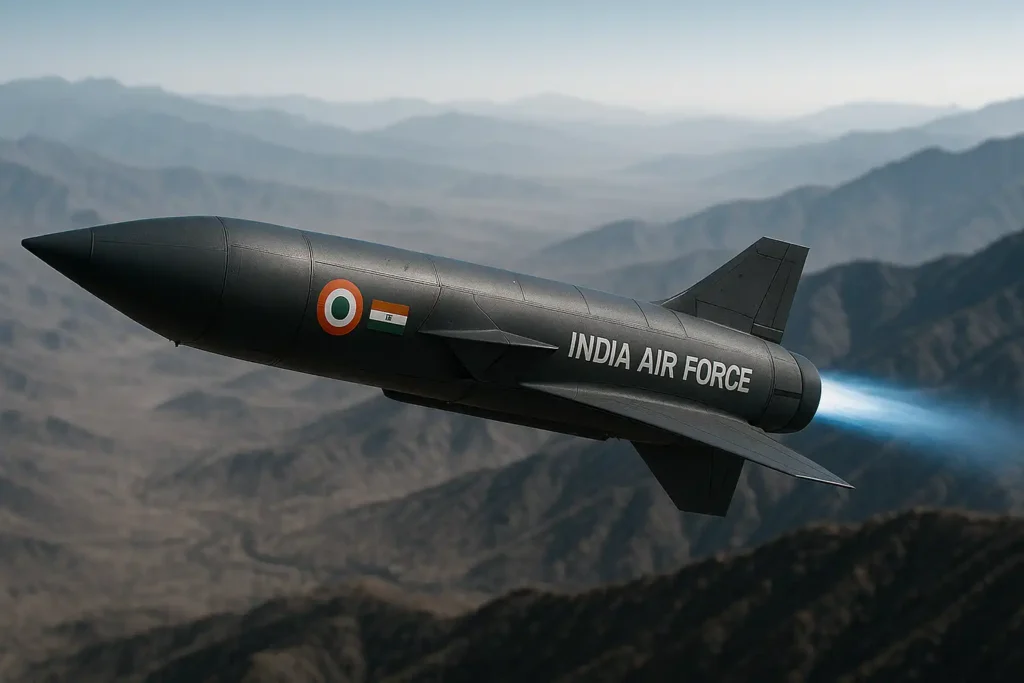
Within the Rudram missile series, the Rudram 4 represents the most significant leap, pushing India into the elite class of hypersonic strike weapons. It is being developed to achieve speeds beyond Mach 5, placing it in the exclusive league of hypersonic strike weapons.
What makes it truly stand out, in my view, is the way it combines raw speed, extended range, and stealth design to carry out Suppression of Enemy Air Defences (SEAD) with unmatched precision. For the Indian Air Force, this means the ability to blind enemy radars and open the skies for deeper operations, something no earlier Rudram variant could achieve.
Evolution of the Rudram Series: Accurate Timeline
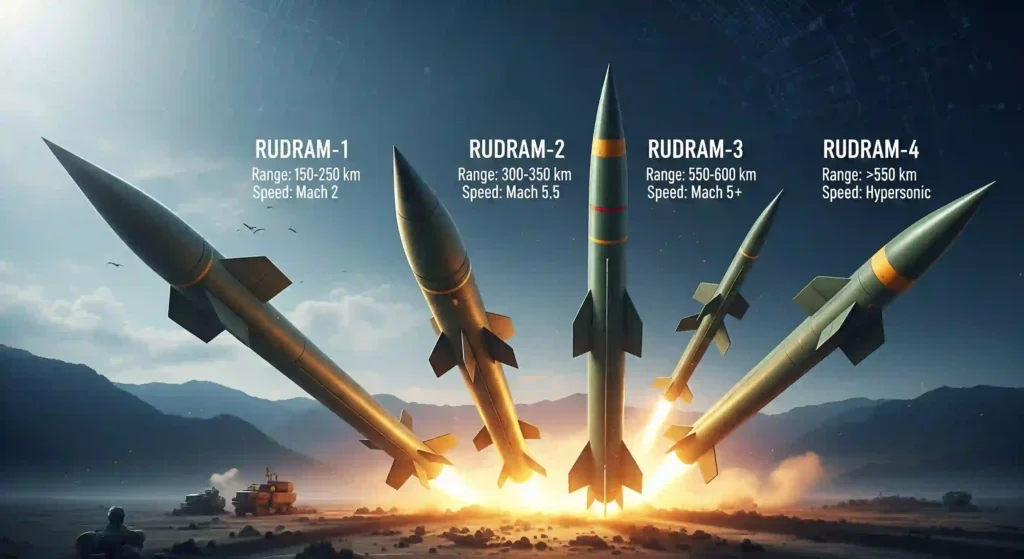
Evolution of the Rudram Series
The Rudram programme is India’s journey from its first anti-radiation missile to a cutting-edge hypersonic strike weapon. Each step added more speed, range, and mission complexity.
- Rudram-1: India’s first indigenous anti-radiation missile, flying at Mach 2 with a 200 km range. It gave the Indian Air Force its initial SEAD capability and proved India could blind enemy radars.
- Rudram-2: Under testing, reaching Mach 5.5 with a 300 km range. It expands roles from radar suppression to precision ground strikes, marking India’s first serious push into hypersonic tech.
- Rudram-3: In development as a deep strike missile, expected to exceed Mach 3 with 550 km range. This missile bridges tactical and strategic roles, allowing India to strike deep inside enemy territory with greater precision.
- Rudram-4: The most advanced, a hypersonic Long-Range Stand-Off Weapon (LRSOW). Designed to fly beyond Mach 5 and strike past 1,000 km, it gives the IAF the ability to cripple air defences long before a dogfight begins.
In my view, the Rudram series is more than incremental upgrades. India’s steady march toward building an indigenous hypersonic arsenal will shape the future of aerial warfare.
Rudram 4: Confirmed and Estimated Specifications
The Rudram 4 hypersonic missile is designed for speed, survivability, and precision, making it a true game-changer for the Indian Air Force.
- Range: Expected to exceed 1,000 km, with some reports suggesting up to 1,500 km.
- Speed: Hypersonic, flying at Mach 5+.
- Trajectory: Low-altitude, quasi-ballistic path to evade interception.
- Propulsion: Likely dual-pulse solid rocket, with possible scramjet use in future.
- Guidance: INS + GPS/NavIC mid-course, with passive radar or IIR seeker for terminal accuracy.
- Warhead: High-explosive fragmentation, optimised to destroy radars, command centres, and communication hubs.
Rudram 4’s blend of long-range, hypersonic speed, and precision targeting signals India’s strategic leap in modern air warfare.
Why Hypersonic and LRSOW Capabilities Matter
The future of air warfare is shaped by the first-strike advantage. The side that strikes first and blinds enemy defences gains control of the skies. This is why hypersonic Long-Range Stand-Off Weapons (LRSOWs) such as the Rudram 4 are true game-changers.

- Out-of-Range Engagement: Enables Indian aircraft to strike deep targets while staying well beyond enemy radars and missile envelopes.
- Rapid Time-to-Target: Flying at Mach 5+, Rudram-4 leaves adversaries with almost no reaction time.
- Radar Evasion: Its low-altitude, manoeuvring flight path makes tracking and interception extremely difficult.
- Accuracy in Hostile Zones: A passive homing seeker ensures precise targeting even in jammed or electronically contested environments.
The Rudram 4 hypersonic missile ensures India can neutralise critical threats early in a conflict, creating safer skies for fighters and bombers to strike freely.
Integration with Indian Air Force Platforms
The Rudram 4 is being developed to integrate seamlessly with both current frontline fighters and upcoming next-generation platforms of the Indian Air Force.
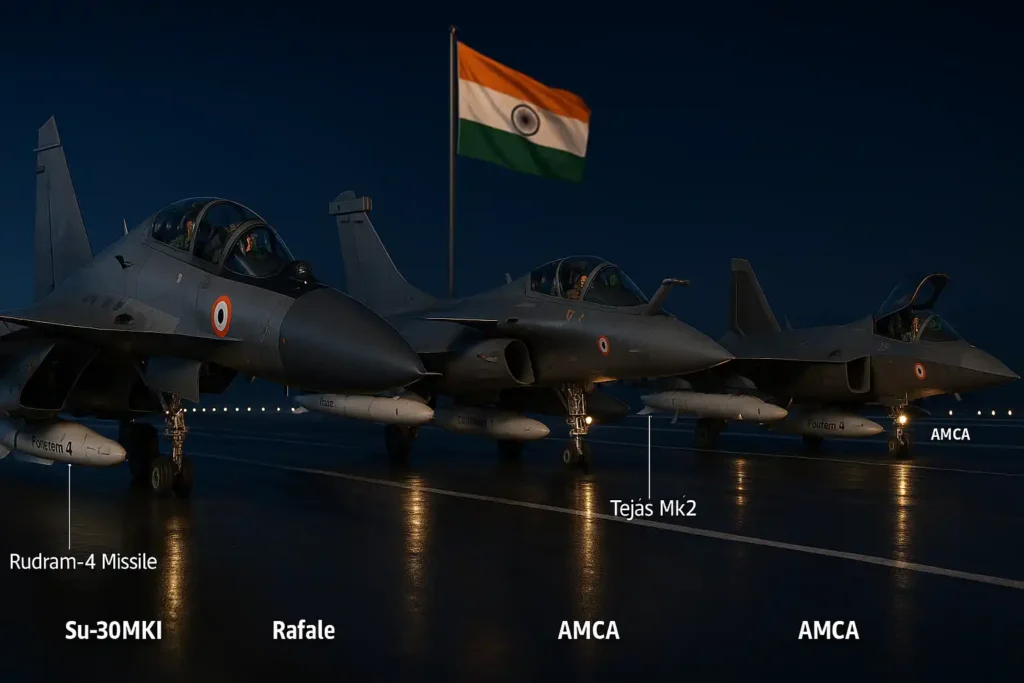
- Su-30MKI: Serving as the primary test platform, carrying out initial trials.
- Mirage 2000 and Rafale: Planned for integration in the next phases to expand strike options.
- Tejas Mk1A and Mk2: Future indigenous fighters expected to carry Rudram-4 as part of India’s Atmanirbhar push.
- AMCA and UCAVs: Long-term deployment on fifth-generation stealth jets and unmanned combat aircraft.
Each platform requires custom mission software, aerodynamic tuning, and extensive flight-testing to ensure the Rudram 4 hypersonic missile performs with maximum accuracy and reliability. For me, this adaptability shows that Rudram 4 is not just a missile for today but a future-ready asset designed to serve across generations of aircraft.
Rudram 4’s Strategic Role in India’s Defence Doctrine
The Rudram 4 is more than just a missile. It plays a decisive role in shaping India’s future air warfare strategy:
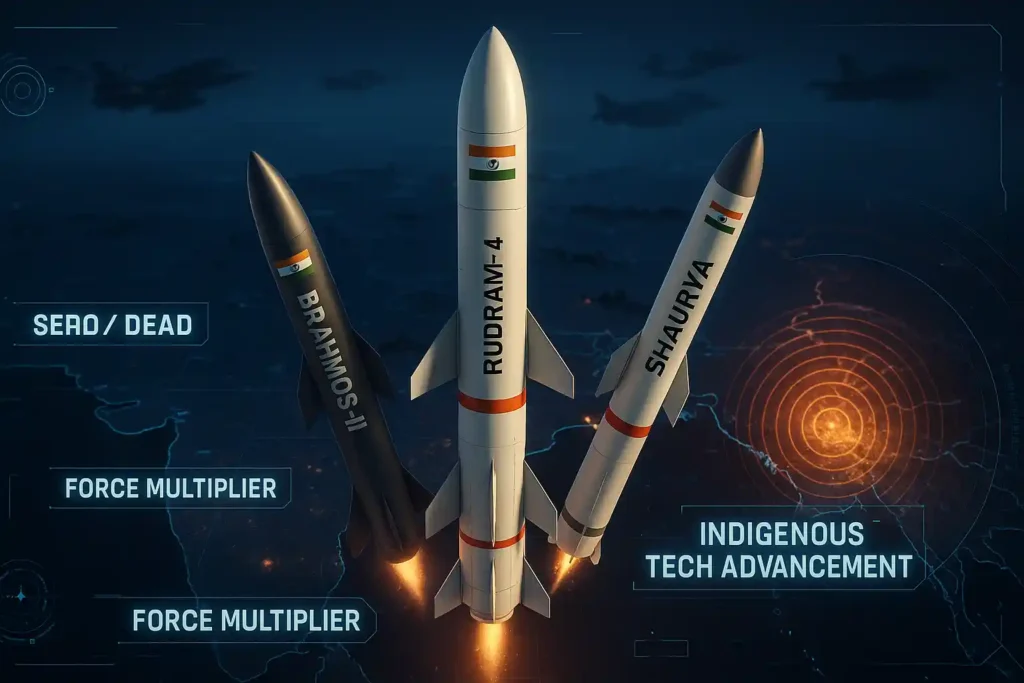
- SEAD/DEAD Capability: Designed to blind and cripple enemy air defences, giving Indian pilots clear skies to operate.
- Force Multiplier: Works in tandem with BrahMos-II and Shaurya missiles, creating a layered strike ecosystem.
- Indigenous Advancement: Showcases India’s ability to develop high-end hypersonic weapons through its own R&D.
- Deterrence: Its presence alone compels adversaries to rethink their defence planning and deployments.
The Rudram 4 hypersonic missile fits seamlessly into India’s vision of network-centric and self-reliant warfare, where speed, precision, and indigenous innovation define battlefield dominance.
Technical and Operational Challenges
Building a missile like the Rudram 4 hypersonic LRSOW is no easy task. Each stage of development brings its own set of hurdles:
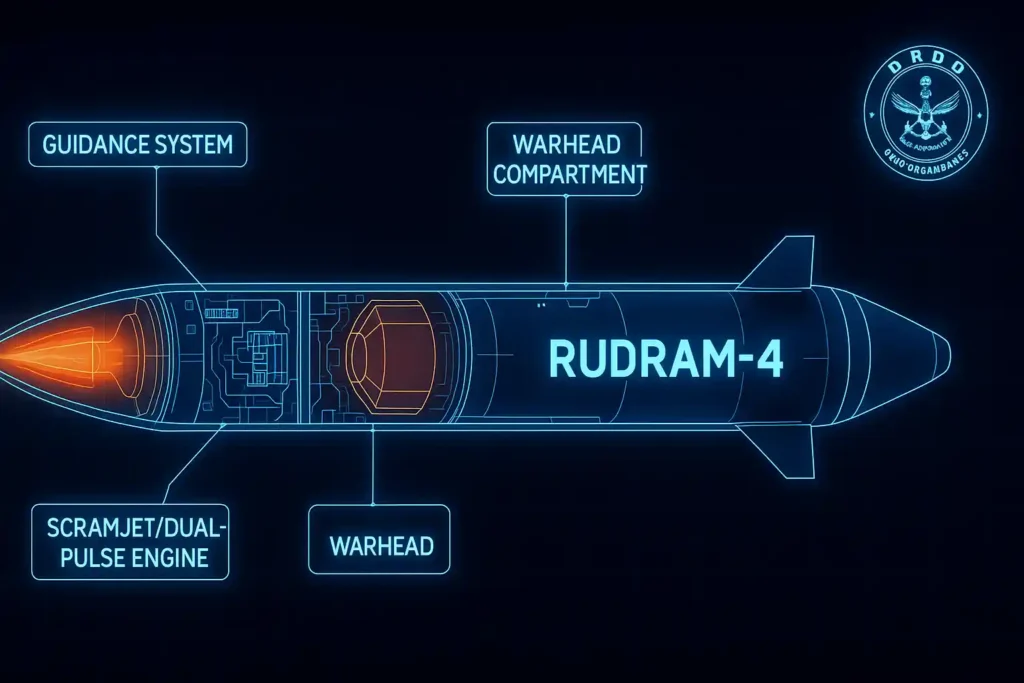
- Thermal Management: The missile must withstand the extreme heat generated at hypersonic speeds without compromising performance.
- Seeker Reliability: Precision guidance has to remain effective even in electronically jammed and contested environments.
- Integration Complexity: Every aircraft, from the Su-30MKI to future AMCA jets, requires custom software and aerodynamic tuning for smooth deployment.
- Production Readiness: Moving from prototypes to mass production demands strict quality control and cost efficiency.
These challenges highlight the gap between building a test article and fielding a combat-ready hypersonic system for the Indian Air Force. Overcoming them will be the true test that takes Rudram 4 from the lab to the frontline squadrons of the Indian Air Force.
DRDO Chief’s Transparency: A New Approach
On 24 August 2025, DRDO Chief Dr. Samir V. Kamat made an unusual statement: “One can use the internet to find some information about Rudram 4.” For a programme still under development, this was a rare public acknowledgement.
This openness serves multiple purposes:
- Public Trust: Shows India’s confidence in sharing its progress.
- Academic Interest: Encourages researchers and defence analysts to study indigenous programmes.
- Confidence in R&D: Reflects the maturity of DRDO’s hypersonic work.
- Strategic Signalling: Projects India’s self-reliant defence innovation as a form of soft power.
This moment marked a clear shift. India is now confident enough to openly acknowledge its hypersonic ambitions, projecting strength both at home and on the global stage.
What’s Ahead: Rudram-5 and Beyond
The Rudram programme does not stop with Rudram 4. Future variants already hint at an even more ambitious roadmap:
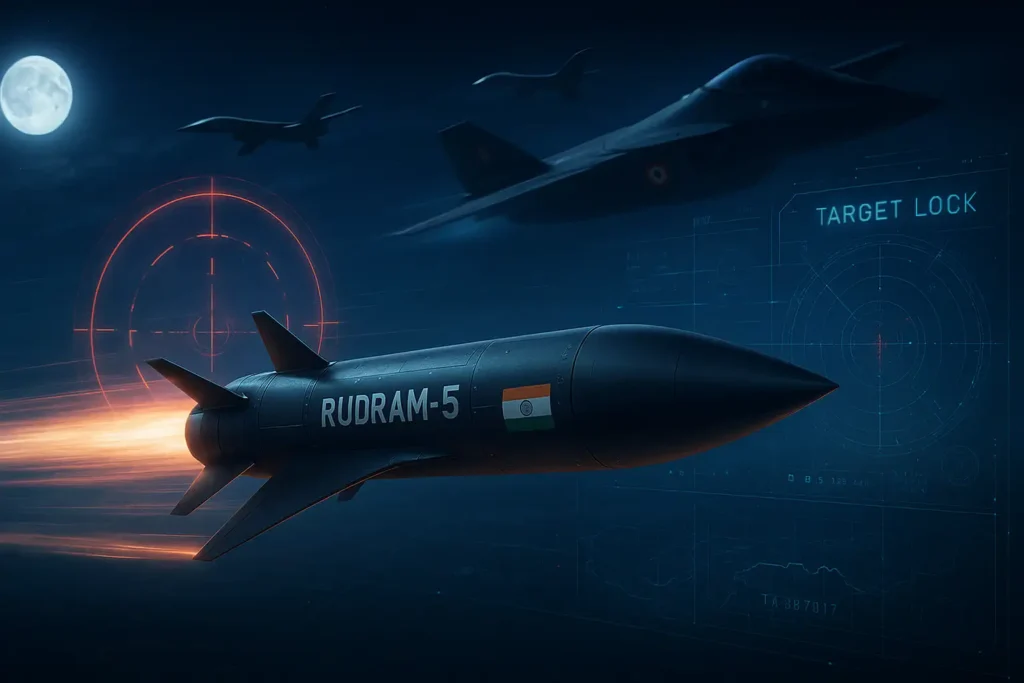
- Rudram-5: Envisioned as a lighter, stealth-optimised successor for next-generation missions.
- Increased Automation: Integration of AI-assisted targeting and seeker logic to improve precision in complex environments.
- Drone Compatibility: Potential to arm UCAVs and loyal wingman drones, expanding unmanned strike capability.
- Export Potential: Once inducted, the Rudram family could become part of India’s defence exports, strengthening global partnerships.
This forward-looking strategy reflects India’s intent to move beyond self-reliance and emerge as a global supplier of advanced hypersonic missile systems.
Conclusion
The Rudram 4 is not just another missile; it represents a giant leap in Indian air warfare. With its blend of hypersonic speed, stand-off range, and precision, it gives the Indian Air Force both a formidable deterrent and a decisive offensive edge.
Backed by indigenous R&D, strong government support, and rigorous testing, Rudram 4 is set to become a cornerstone of India’s hypersonic arsenal. It stands as a symbol of India’s technological confidence and strategic foresight, ensuring secure skies while keeping adversaries uncertain of their next move.
FAQs
Q1: Is Rudram 4 hypersonic?
Yes, it is designed to fly above Mach 5, placing it in the hypersonic class.
Q2: What is its estimated range?
It is expected to have a range exceeding 1,000 km.
Q3: What aircraft can carry Rudram 4?
Su-30MKI, Mirage 2000, Rafale, Tejas Mk2, and future AMCA platforms.
Q4: When will Rudram-4 enter service?
Based on current progress, initial operational capability is expected in 3–4 years.
Q5: How is it different from Rudram-1?
Rudram 4 has a hypersonic speed, a longer range, and is designed for deep-strike SEAD roles.
“What do you think Rudram 4 means for India’s future warfare strategies? Join the discussion below or explore more on DRDO’s innovations.”
